Dry-Brined Turkey
This post may contain affiliate links. Read my full disclosure policy.
Discover the secret to a perfectly juicy and flavor-packed bird with this easy dry-brined turkey recipe—it’s a holiday game-changer!
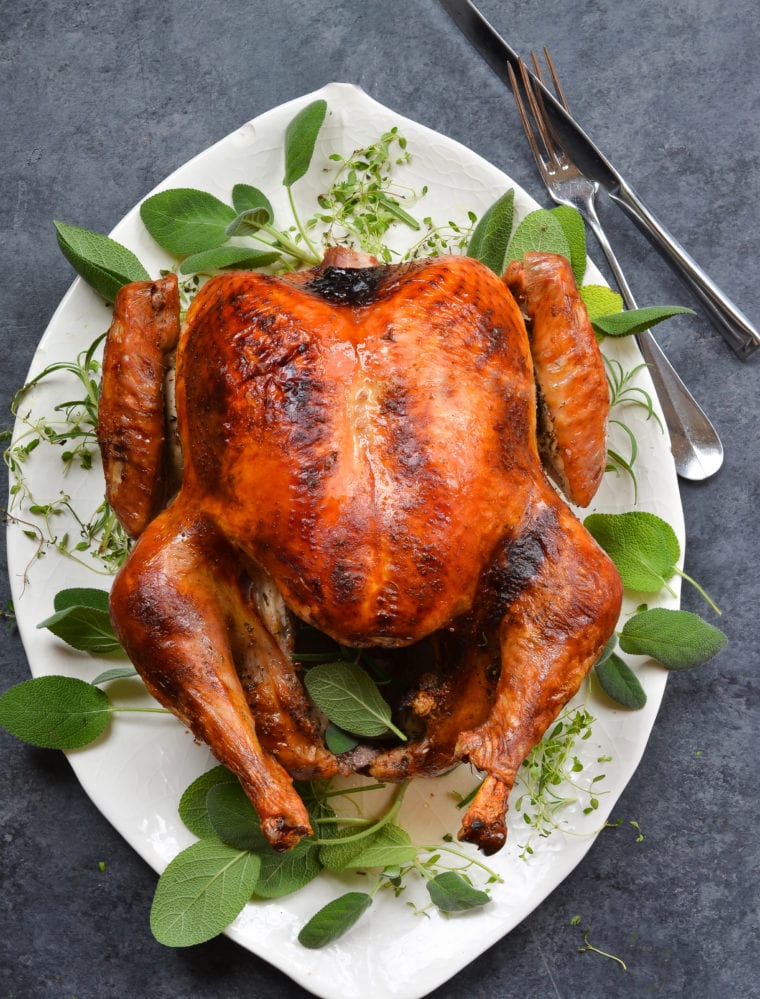
This fantastic dry-brined turkey recipe was shared with me by the talented food stylist Rebecca Jurkevich, who styled my second cookbook. Rebecca told me it was the best turkey she’d ever made—and she’s made her fair share! Adapted from Jeff Mauro and featured in Rachel Ray Magazine, the recipe’s biggest draw is its simplicity.
You start by rubbing a salt and seasoning mixture—the dry brine—onto the turkey’s skin, then let it rest in the fridge overnight. The salt not only deeply seasons the meat but also draws out the turkey’s natural juices, creating a self-brine that the meat reabsorbs, guaranteeing flavorful, juicy, tender results from the inside out. Plus, the overnight rest in the fridge dries out the skin, so when you cook it, you end up with the most beautifully crispy, golden-brown exterior. Whether you’re a seasoned cook or tackling Thanksgiving turkey for the first time, this dry-brine method is a must-try for its ease and reliability.
Table of Contents
“My husband just declared this is the best turkey we’ve made in 40 years!!!! I concur!!”
Wet Brining vs. Dry Brining
Dry brining involves rubbing salt, herbs, and spices onto the turkey skin and letting it rest in the fridge overnight (or longer). In contrast, wet brining requires soaking the turkey in a seasoned saltwater solution, which often means dealing with a large cooler or bag—a process that can be quite cumbersome. Both methods enhance flavor and juiciness, but dry brining is much simpler and produces beautifully crisp skin.
What You’ll Need To Make A Dry-Brined Turkey
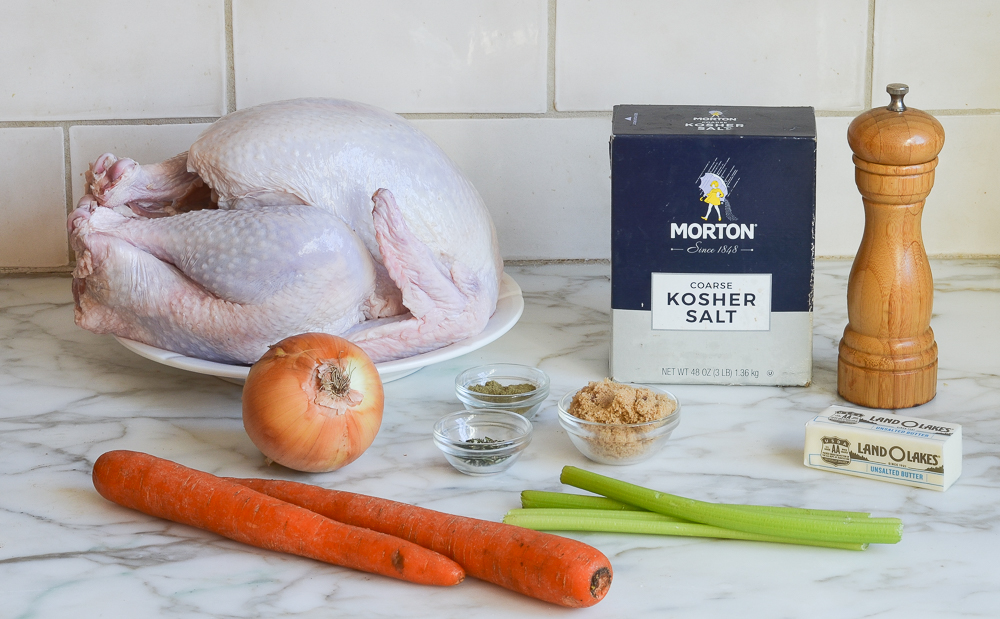
- Turkey – For the best results with this dry-brining method, avoid kosher turkeys, injected turkeys, or self-basting turkeys. These birds have already been treated with salt or a brining solution. However, if you can only find one of these, you can still use this recipe—just halve the amount of salt in the dry brine to avoid over-salting.
- Light brown sugar – Adds a touch of sweetness to balance the salt in the brine and enhances the turkey’s natural flavors.
- Kosher salt – The essential component of the dry brine; it draws moisture out of the skin for extra-crispy results while seasoning the meat throughout. I use Morton brand kosher salt; if you’re using Diamond Crystal kosher salt, which has lighter, flakier grains, you’ll need to increase the amount to ¼ cup to achieve the same level of seasoning. The difference is due to the way the salts are processed: Morton has denser, more compact granules, so it measures saltier per tablespoon than the lighter Diamond Crystal.
- Herbs (dried thyme and sage) – Infuse the turkey with earthy, savory flavors and bring that quintessential holiday flavor.
- Freshly ground black pepper – Provides a mild, peppery bite to balance the other seasonings.
- Unsalted butter – Coats the turkey for baking, enhancing richness and helping to brown the skin.
- Aromatics (yellow onion, carrots, and celery) – Add depth and sweetness to the drippings, creating a flavorful base for the gravy.
- Jump to the printable recipe for precise measurements
Step-by-Step Instructions
In a small bowl, mix the sugar, salt, thyme, sage, and pepper for the dry brine.
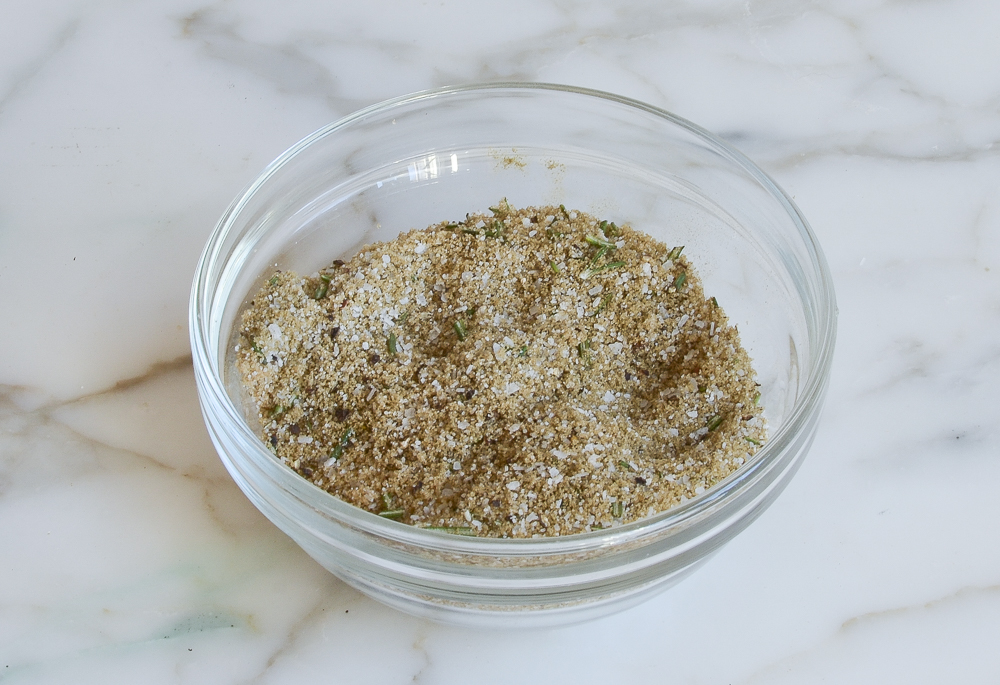
Place the turkey breast side up on the rack of a baking sheet. Rub and pat the dry brine all over the turkey, including inside the cavity. Refrigerate, uncovered, for at least 24 hours and up to 48 hours. The longer you allow the turkey to brine, the more flavorful and moist it will be, but don’t go past the max recommended time.
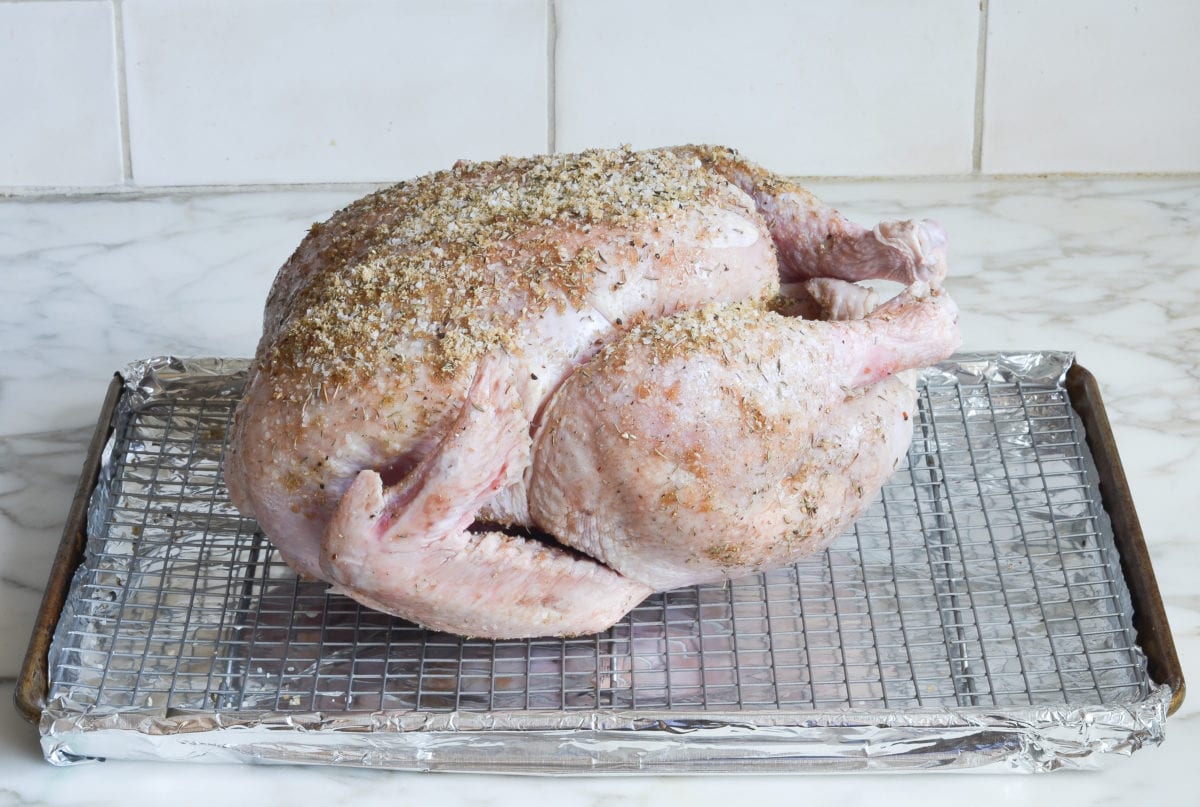
Using damp paper towels, brush the dry brine off the turkey.
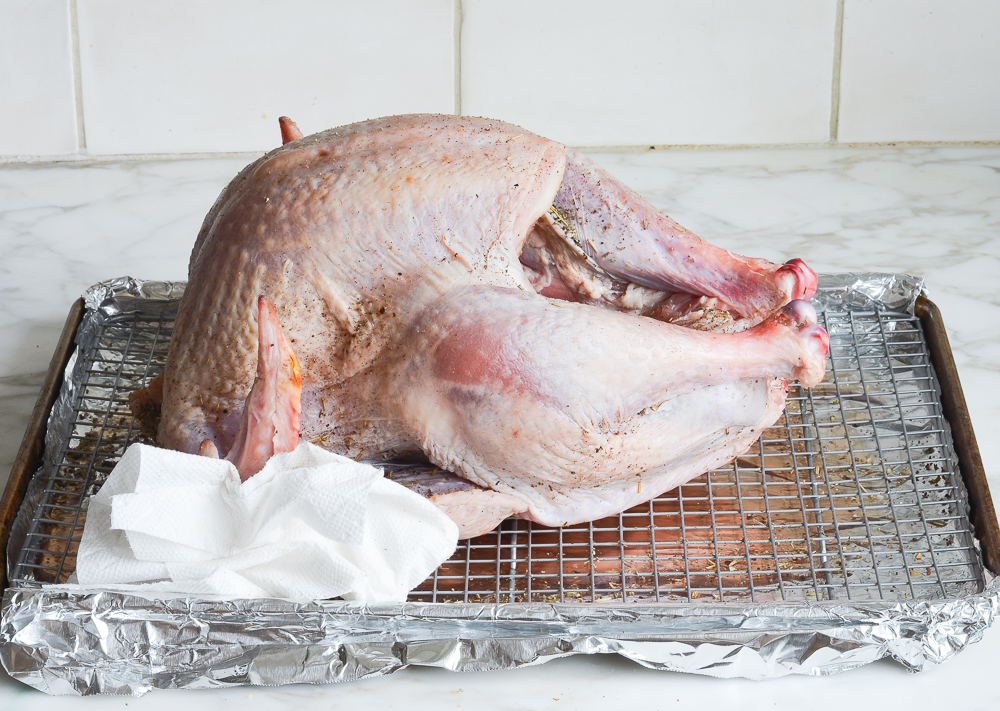
Scatter the onion, carrots, and celery in the bottom of a large roasting pan. Place a roasting rack inside the pan and place the turkey on the rack. Tuck the wings underneath the bird.
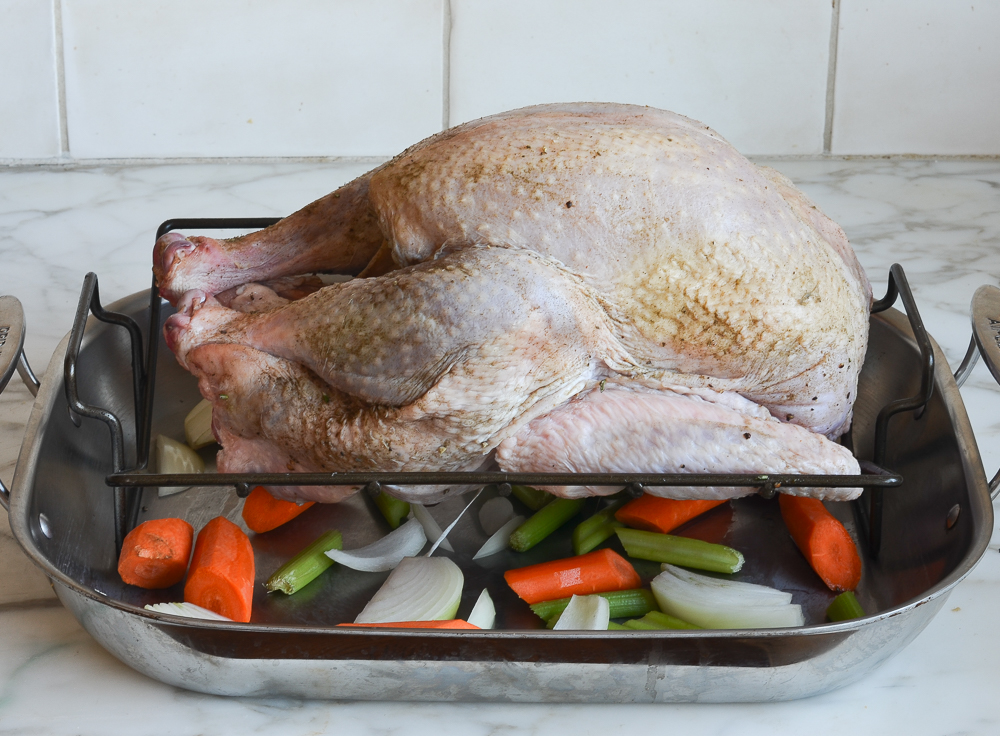
Using your hands, smear the butter all over the turkey.
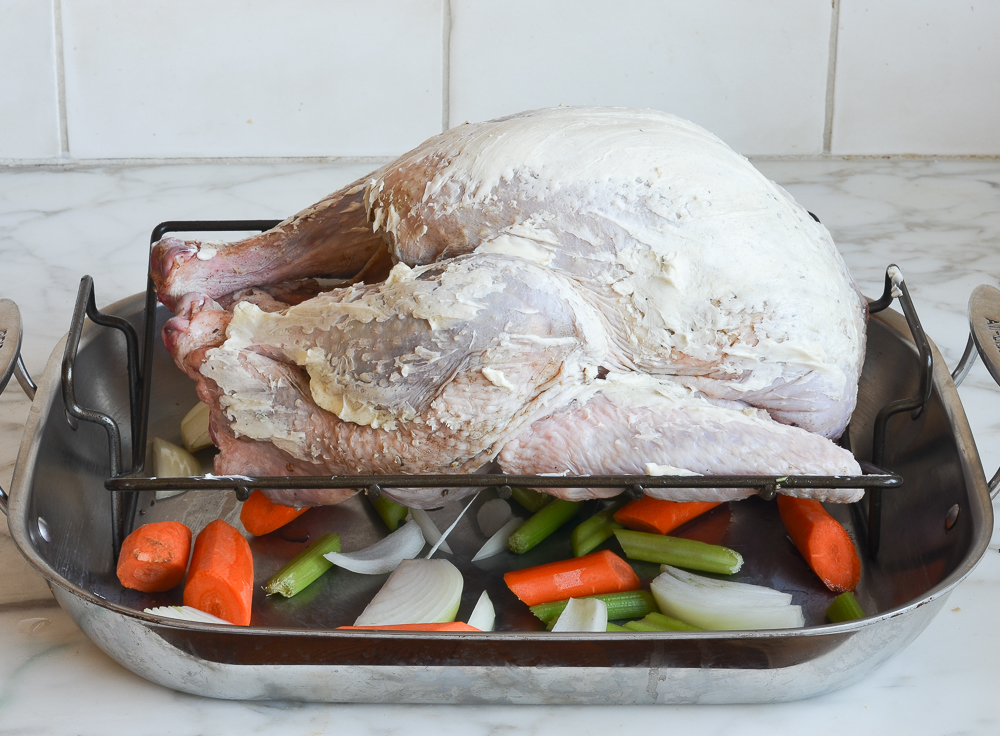
Roast the turkey until the skin is deep golden and an instant-read thermometer registers 165°F when inserted into the thickest part of the breast and the thigh, 1-3/4 to 2-1/2 hours. Check the turkey after 1-1/2 hours. If it’s getting too dark, cover it loosely with foil.
Note: The cooking time will depend on the size of your turkey. For best results, I recommend using a digital thermometer with a leave-in probe and remote monitor, like the one shown below. That way, you can monitor the temperature of the turkey without ever opening your oven.
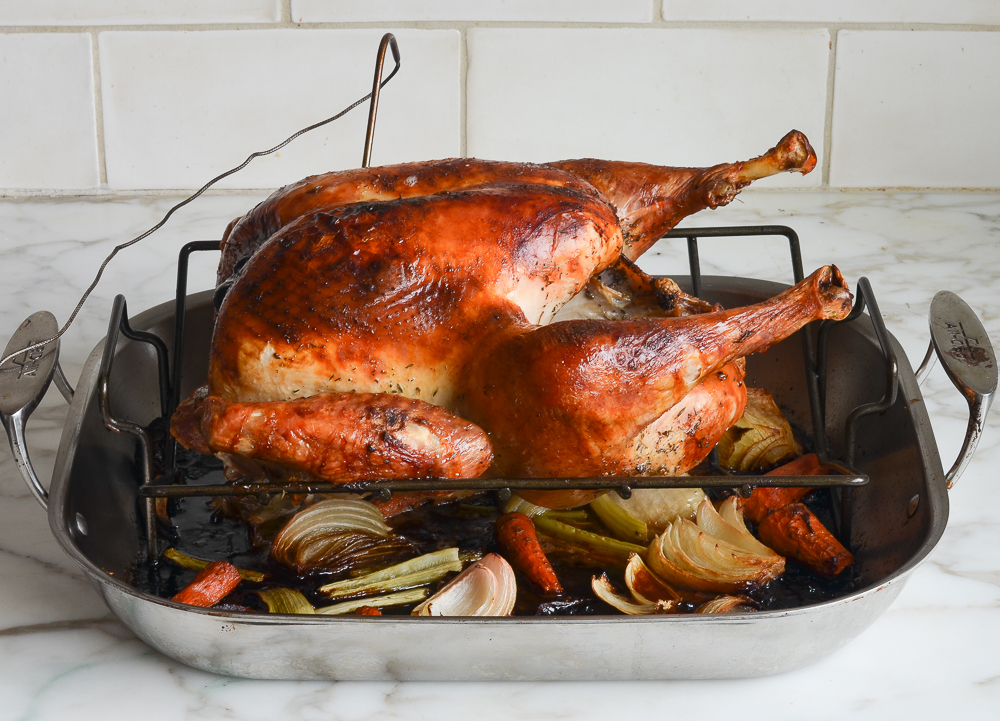
Using clean oven mitts (that you don’t mind getting dirty), carefully tilt the turkey so any juices from the cavity pour into the roasting pan. Transfer the turkey to a platter or cutting board. Tent with foil and let rest for 20 to 30 minutes. Remove the vegetables from the pan and discard (or if they aren’t too soft/brown, save them and arrange on the serving platter with the turkey). Reserve the drippings in the pan for the gravy. While the turkey rests, make the turkey gravy.
Carve the turkey and serve with the gravy on the side. Serve with stuffing and cranberry sauce.
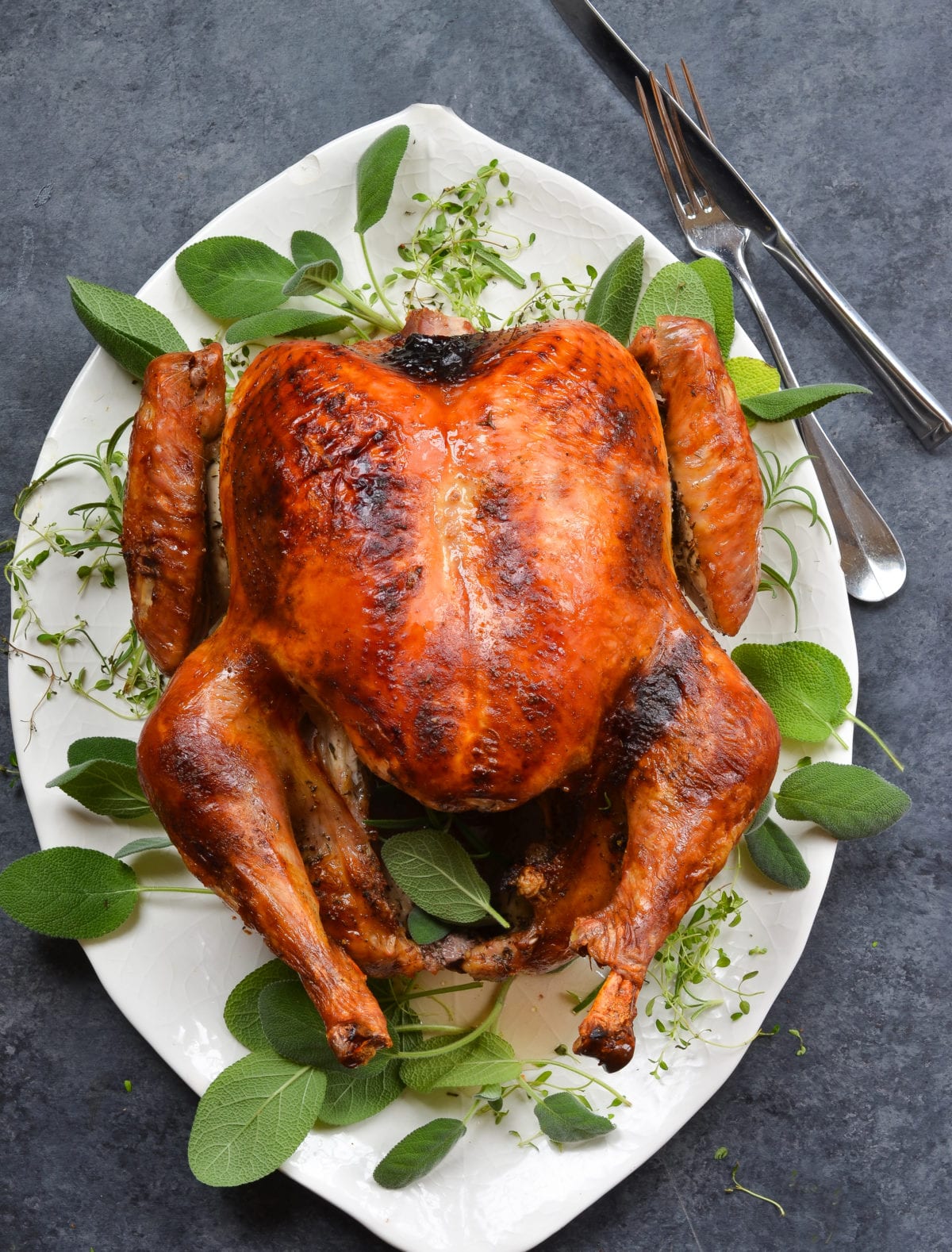
You May Also Like
Dry-Brined Turkey
Discover the secret to a perfectly juicy and flavor-packed bird with this easy dry-brined turkey recipe—it’s a holiday game-changer!
Ingredients
- 1 (12 to 14-pound) turkey, patted dry (see note)
- ¼ cup (packed) light brown sugar
- 3 tablespoons Morton kosher salt (or ¼ cup Diamond kosher salt)
- 2 teaspoons dried thyme
- 2 teaspoons dried sage leaves or ground sage
- 1 teaspoon freshly ground black pepper
- 6 tablespoons unsalted butter, at room temperature
- 1 large yellow onion, cut into wedges
- 2 carrots, cut into 2-inch pieces
- 2 stalks celery, cut into 2-inch pieces
Instructions
- Line a rimmed baking sheet with aluminum foil for easy clean up, and set an oven rack on top.
- Remove and discard the truss that holds turkey legs together (if the legs are held together with turkey skin, cut the skin to release them). Trim off and discard any excess fat in the neck or body cavity. Remove giblets and neck; discard or save for stock. Rinse the turkey inside and out with warm water. Pat dry with paper towels.
- In a small bowl, mix the sugar, salt, thyme, sage, and pepper for the dry brine. Place the turkey on the rack of the prepared baking sheet. Rub and pat the dry brine all over the turkey, including inside the cavity. Refrigerate, uncovered, for at least 24 hours and up to 48 hours. (For food safety, ensure the turkey remains in the refrigerator at 40°F or lower during the entire brining period. If brining for longer than 24 hours, you can cover the turkey loosely with plastic wrap for the first part of the brining process and then uncover it for the final 24 hours to allow the skin to dry.)
- Preheat the oven to 375°F and set an oven rack in the lower third of the oven. Using damp paper towels, brush the dry brine off the turkey.
- Scatter the onion, carrots, and celery in the bottom of a large roasting pan. Place a roasting rack inside the pan and place the turkey on the rack. Tuck the wings underneath the bird. Using your hands, smear the butter all over the turkey.
- Roast the turkey until the skin is deep golden and a leave-in or instant-read thermometer registers 165°F when inserted into the thickest part of the breast and the thigh, 1¾ to 2½ hours (see note). Check the turkey after 1½ hours. If the skin is getting too browned, cover it loosely with foil.
- Using clean oven mitts (that you don't mind getting dirty), carefully tilt the turkey so any juices from the cavity pour into the roasting pan. Transfer the turkey to a platter or cutting board. Tent with foil and let rest for 20 to 30 minutes. Remove the vegetables from the pan and discard (or if they aren't too soft/brown, save them and arrange on the serving platter with the turkey). Reserve the drippings in the pan for the gravy.
- While the turkey rests, make the gravy.
- Carve the turkey and serve with the gravy on the side.
- Make-Ahead Instructions: If you don't mind losing the crispy skin, the turkey can be roasted and carved ahead of time. Pour a thin layer of the gravy into an ovenproof serving dish. Arrange the carved turkey nicely on top of the gravy; cover tightly with plastic wrap and refrigerate for up to two days. Refrigerate the remaining gravy in a separate container. To reheat: remove the plastic wrap and cover the platter with aluminum foil. Place in a 325°F-oven for 20 to 30 minutes, until the turkey is hot. Reheat the gravy in the microwave or on the stovetop.
- Note on Selecting Your Turkey: For the best results with this dry-brining method, look for a turkey that is not kosher, injected, or labeled as "self-basting." These types of turkeys have already been treated with salt or a brining solution. However, if you can only find a kosher, injected, or self-basting turkey, you can still use this recipe, as these birds do still benefit from additional seasoning. Just halve the amount of salt in the dry brine to avoid over-salting.
- Note: I've given a range for the cooking time, which will depend on the size of your turkey. For best results, I recommend using a digital thermometer with a leave-in probe and remote monitor (like this one). That way, you can monitor the temperature of the turkey without ever opening your oven.
Pair with
Nutrition Information
Powered by ![]()
- Per serving (8 servings)
- Calories: 1,075
- Fat: 47 g
- Saturated fat: 15 g
- Carbohydrates: 6 g
- Sugar: 5 g
- Fiber: 0 g
- Protein: 147 g
- Sodium: 1,619 mg
- Cholesterol: 513 mg
This website is written and produced for informational purposes only. I am not a certified nutritionist and the nutritional data on this site has not been evaluated or approved by a nutritionist or the Food and Drug Administration. Nutritional information is offered as a courtesy and should not be construed as a guarantee. The data is calculated through an online nutritional calculator, Edamam.com. Although I do my best to provide accurate nutritional information, these figures should be considered estimates only. Varying factors such as product types or brands purchased, natural fluctuations in fresh produce, and the way ingredients are processed change the effective nutritional information in any given recipe. Furthermore, different online calculators provide different results depending on their own nutrition fact sources and algorithms. To obtain the most accurate nutritional information in a given recipe, you should calculate the nutritional information with the actual ingredients used in your recipe, using your preferred nutrition calculator.
Gluten-Free Adaptable Note
To the best of my knowledge, all of the ingredients used in this recipe are gluten-free or widely available in gluten-free versions. There is hidden gluten in many foods; if you're following a gluten-free diet or cooking for someone with gluten allergies, always read the labels of your ingredients to verify that they are gluten-free.

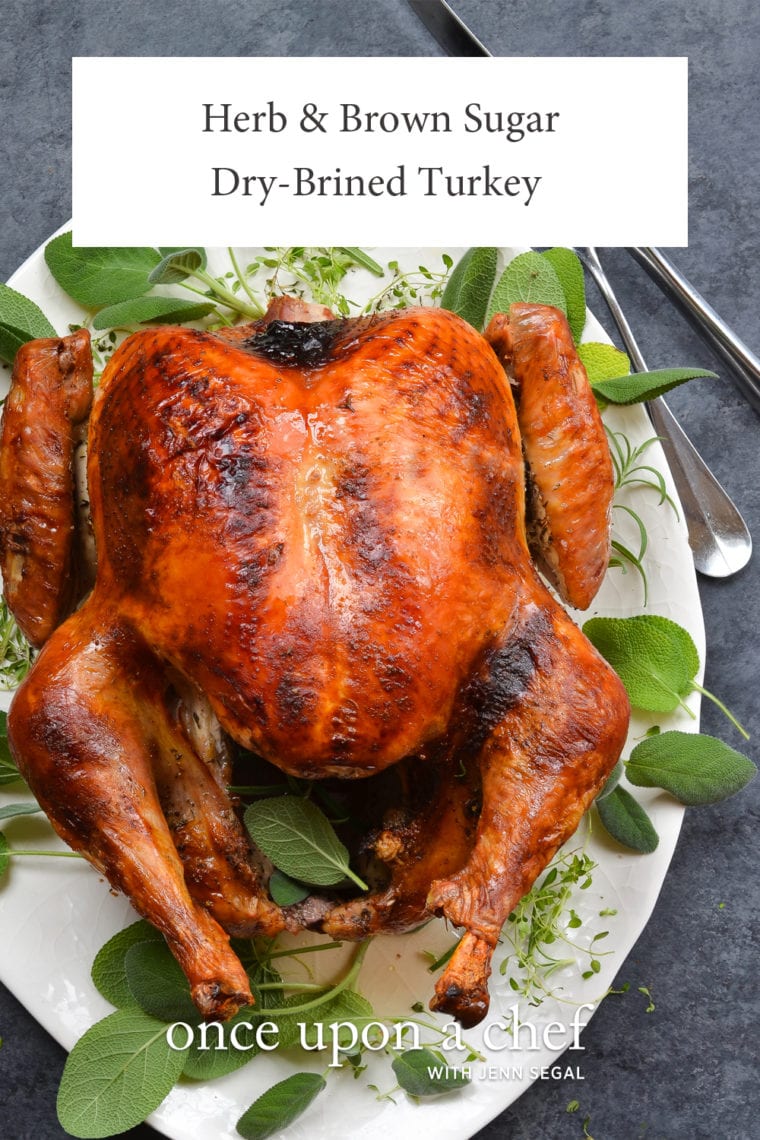
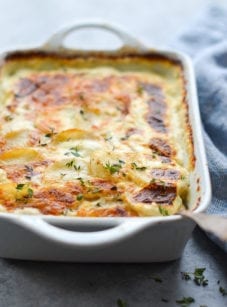
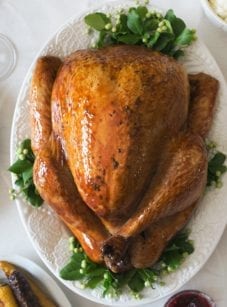
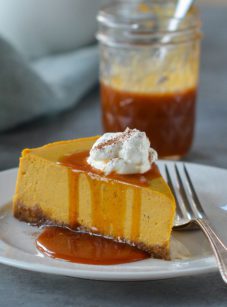
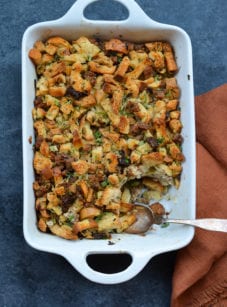
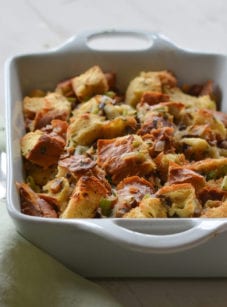
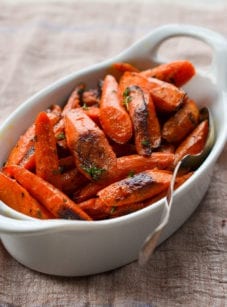
Also my turkey probably wasn’t as dry as it should have been when i rubbed the brine on it – is that going to ruin it?
Hi Jen, It will dry out in the fridge; I wouldn’t worry about it.
Hi Jenn
I have ancient kosher sea salt, will that work? and do i need to adjust?
Thanks so much
Melissa
Hi Melissa, Kosher salt pretty much lasts forever so you should be fine with no adjustments. Hope you enjoy!
HI Jen! Similar to other reviews I have used Alton’s recipe in the past but tired of a wet brine! Excited to try this…..what is your recommended brine time? Do you do 24 or closer to 48?
Hi Jen, as long as you brine it for at least 24 hours, you’ll get the same amount of flavor if you do it for several hours beyond that. (The flavor doesn’t increase exponentially based on the number of hours you brine it.) Hope that clarifies and that you enjoy!
Hi Jenn, I’m planning on trying this recipe for my thanksgiving turkey, however I plan to spatchcock my turkey. Will this work the same on a spatchcocked turkey? I’m guessing the cooking tine would be less.
Hi Pam, Yes the recipe should work really well with a spatchcocked turkey. The cooking time would definitely be less; I’m guessing 6 to 8 minutes per pound (but always check with a thermometer).
Hi Jenn- I have dark brown sugar, is it ok to substitute that for the light brown? Thanks!
Sure!
Hi Jenn~ I have a 20-pounder and just noticed a comment that stated this should be cooked at 325-degrees. The recipe says 375-degrees. Can you please clarify? Happy Thanksgiving! Thank you for so many outstanding recipes!
Hi Rebecca, Yes a larger bird should be cooked at 325 so the skin doesn’t burn before the turkey is cooked through. Hope that clarifies!
Hi Jenn, my mom says this is an excellent recipe so I’m looking forward to trying it. Can I do this dry brine & then cook it in my Big Easy Oil-less Turkey fryer?
Yep!
Hi Jenn! Only ever did wet brines, but after all the positive comments, I’d like to try this dry brine recipe. My bird is 23 lbs and your responses say to cook that size turkey at 325. My question: Should the oven be started at 375 then lowered after a certain amount of time? Or just start to finish at 325? BTW: YOU ARE MY GO TO!!!
So glad you like the recipes! For that size turkey, I’d keep the oven temp at 325°F the whole time. Hope you enjoy!
I make roast chicken with lemon, herbs, and garlic in the cavity. Would that help keep the turkey juicy or is it a bad mix of flavors with this rub? Thanks
Hi Matt, That will work well here. Please LMK how it turns out!
Used this dry-brine last year and stuffed it with lemons, herbs, and garlic. It all turned out really well. I’m doing it again this year. We also made your cranberry sauce (with less orange) last year and it was great. Trying your gravy with everything this year. Thanks!
Does the brown sugar make this sweet tasting? I have a 21 lb turkey I’m planning on trying this on. I have dry brined before but it didn’t have sugar. I’m relatively new to your recipes but so far the ones I’ve tried have been wonderful. Thank you!
Hi Galen, the skin has a very subtle sweet flavor but you really won’t notice it once you’ve cooked it and added gravy to the mix. Glad to hear you’ve enjoyed the recipes to try so far and hope you enjoy this one if you make it!